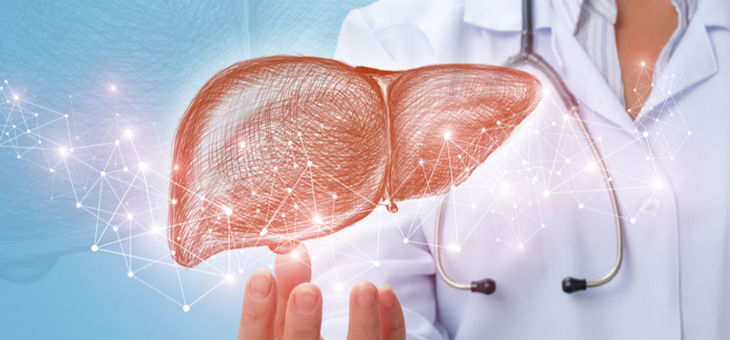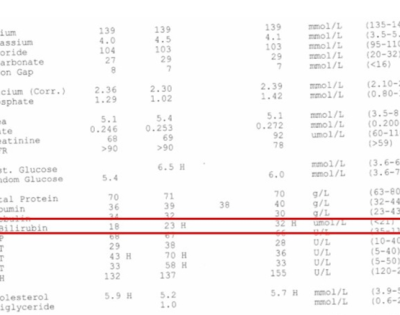Gilbert’s Syndrome Natural Treatment
Perhaps you’ve received diagnosis of Gilbert’s Syndrome and been told it’s a benign, harmless, genetic condition that you can do nothing about so don’t worry about it?

With further research, you will find that many people with Gilbert’s Syndrome are fatigued, don’t tolerate stress, alcohol, caffeine or medications so well, have a sluggish digestion and may have also issues with hormone clearance (e.g. PCOS).
Simply put, this is because your liver is not functioning as optimally as somebody who doesn’t have Gilbert’s Syndrome.
Gilbert’s Syndrome describes an issue with the liver’s Phase II Glucuronidation pathway. This pathway eliminates many endogenous toxins (self-produced), it is also believed to be responsible for removing up to 70% of exogenous (or xenobiotic) toxins from the body.
This impairment can leave you feeling a little bit hung over every single day… you may even find that the smell of perfumes in the department stores are overwhelming.
Now don’t fear, for there are many things you can do to support your body and nourish your liver naturally… and if you read on, you’ll find that there are even some benefits to having Gilbert’s Syndrome.
Introduction
Gilbert’s Syndrome was first described in 1901 by Nicolas Augustine Gilbert and Dominique Lereboullet. It is a condition that you’re born with but often goes undiagnosed. People with Gilbert’s syndrome inherit a mutated gene (UGT1A1 gene), that affects the liver’s ability to process bilirubin, a waste product that forms during the breakdown of old red blood cells. It has been reported that the prevalence of Gilbert syndrome is between 4% and 16% in different populations.
Gilbert’s Syndrome is a genetic condition that predominately affects the liver and its ability to process Bilirubin; this then affects people’s ability to clear toxins from their body. Gilbert’s Syndrome therefore can go on to have effects on all the body’s systems in some way. Because of this reduced toxin clearance, it may have symptomatic effects on the Endocrine, Integumentary, Digestive, Urinary, Nervous, Reproductive, Lymphatic, Cardiovascular and Immune systems.
Diagnosis
Although it’s present from birth, Gilbert’s syndrome usually isn’t noticed until puberty or later since bilirubin production increases during puberty.
Gilbert’s Syndrome is also more commonly seen in males due to a higher level of daily production of bilirubin.
The taking of medical history, a physical examination and the following blood tests lead to a diagnosis.
Medical Tests
Blood tests – specifically liver function tests and genetic analysis tests, are tests the doctor may use to identify Gilbert’s Syndrome. Genetic testing will provide a definitive diagnosis. We all have bilirubin in our blood and its levels fluctuate and usually sit (for most people) below 15umoL. In people with Gilbert’s Syndrome, there are chronic elevations of bilirubin >17 umoL, often over 25 or 30 umoL.
Genetic tests reveal an abnormal UGT1A1 gene that normally controls the enzyme bilirubin UGT that breaks down bilirubin in the liver. If the body doesn’t produce enough of this enzyme because of the ineffective gene, blood tests will reveal an excess amount of bilirubin, with elevated levels on liver function tests in the presence of no other cause or liver function abnormalities.


Physical Examinations and Presenting Symptoms
The most frequent sign of Gilbert’s syndrome is an occasional yellowish tinge of the skin and the whites of the eyes known as jaundice. This is caused by the elevated levels of bilirubin in the blood.
Other symptoms are sometimes reported, including:
- Gastrointestinal complaints
- Fatigue
- Weakness
- Abdominal pain.
- Digestive
- Psychological symptoms such as depression and anxiety
- Dark coloured urine
- Clay coloured stool
- Dizziness
- Loss of appetite
Gilbert’s Syndrome is exacerbated by
- Illness, such as a cold or the flu
- Fasting or eating a very low-calorie diet
- Dehydration
- Menstruation
- Stress
- Strenuous exercise
- Lack of sleep
Secondary or long-term implications
Secondary effects on the body’s systems from Gilberts Syndrome include the following:
- The Nervous System, when inflammation leads to nervous system stress, and will always present with mood/brain issues and disturbed mood and sleep.
- The Gastrointestinal System is affected by the raised bilirubin level problems that often manifest in the stomach from significantly delayed gastric emptying. There can be pain, a bloated feeling and accompanied irregular bowel movements, diarrhoea, loose stools or constipation or alternate between all of them, food reactions and many other issues. Elevated bilirubin impacts intestinal health negatively because it changes the behaviour of the intestine. It causes re-distribution of the tight junctions of the intestine, setting up leaky gut potentially also leading to food intolerances and parasite/bacterial overload. The pain and discomfort are due to abdominal bloating and the gut issues and sometimes accompanied nausea. Also, having any other condition that impairs the destruction of red blood cells may increase the risk of developing gallstones.
- Hormonal influences affect the Endocrine System and menstrual problems such as heavy bleeding or clotting which can manifest due to the estrogen dominance and conditions such as endometriosis and fibroids as well as fibrocystic breasts and breast cancer.
- The Integumentary System is where the jaundiced colour and temperature of skin shows itself.
- Psychosocial effects are the anxiety and depression. People can often experience significant sleep disturbance further influencing mood and mental state.
- The Immune System is predisposed to autoimmunity because of the major implications of leaky gut to the functioning of the gut.
- Gilbert syndrome patients are also at an increased risk of developing pigment gallstones (cholelithiasis), and especially in patients with other disorders of hemolysis like thalassemia, Sickle cell disease, and hereditary spherocytosis.
Benefits of Gilbert’s Syndrome
Gilbert’s syndrome appears to reduce the risk of various age-related diseases, particularly cancer and atherosclerosis. A population-based cohort study found that mortality rates observed for people with Gilbert’s syndrome in the UK population were shown to be almost half those of people without evidence of Gilbert’s syndrome. One theory that has been postulated to explain this, is that the antioxidant properties of bilirubin have an anti-thrombotic effect via reducing platelet activation. A further population study has shown a significant association between patients with UGT1A1 gene variant and higher respiratory function and lower respiratory disease, with the strongest association being found in smokers, suggesting a protective effect of bilirubin. (Payne 2016). A small study has also found higher bilirubin levels to be a protective factor for those with Covid-19.
In population studies Gilbert’s Syndrome is associated with decreased cardiovascular risk and all-cause mortality. This may be due to the low BMI of those with Gilbert’s Syndrome and possibly decreased production of advanced glycation end products which prevents endothelial dysfunction and reduces progression of atherosclerosis.
Studies have also shown a reduction in the incidence of Hodgkin lymphoma, endometrial cancer, and cancer-related mortality when compared to the general population.
Gilbert’s Syndrome & Medication
Make sure doctors are made aware of any Gilbert’s syndrome diagnosis. Because Gilbert’s syndrome affects the way the body processes certain medications, every doctor you visit needs to know that you have the condition.
The low level of the bilirubin-processing enzyme that causes Gilbert’s syndrome may also increase the side effects of certain medications, since this enzyme plays a role in helping to clear these medications from the body.
Medications known to interact include:
- Paracetamol, aspirin and non-steroidal anti-inflammatories (NSAIDs)
- Irinotecan (Camptosar), a cancer chemotherapy drug
- Some protease inhibitors used to treat HIV
Medications that should be avoided or used with caution include:
- Irinotecan – this drug is prescribed for the treatment of advanced bowel cancer. Deficient liver enzyme overloads the liver with toxicity.
- Atazanavir and Indinavir- physicians use them to treat infections caused by the HIV virus.
- Statins- these are used to control cholesterol levels when consumed with gemfibrozil
- Gemfibrozil – drugs usually prescribed for reducing cholesterol
- Nilotinib- it is used for the treatment of blood cancers.
- Acetaminophen – it can cause further damage to the liver in Gilbert’s Syndrome.
- Antibiotic, Penicillin- someone allergic to penicillin may show liver damage in Gilbert’s Syndrome.
- Paracetamol- Gilbert’s syndrome shows the greatest toxicity of paracetamol after an overdose.
- Nutritional Supplements- any nutritional supplement that has the high concentration of Vitamin A, niacin, vitamin D or cod or halibut liver oil over recommended dose must be avoided as they cannot be completely metabolized by the liver.
- Birth Control Pills- birth control pills are more likely to be processed by the enzyme glucuronyl transferase. Since this enzyme is deficient in Gilbert’s Syndrome, bilirubin levels get elevated in the blood by birth control pills.
Medical Treatments
Most cases of Gilbert’s Syndrome don’t require treatment, however if a person starts to have significant symptoms, including fatigue or nausea, the doctor might prescribe daily phenobarbital (Luminal) to help reduce the total amount of bilirubin in the body.
Since phenobarbital enhances glucuronide formation, its administration significantly reduces the level of unconjugated serum bilirubin in patients with acute hepatitis or Gilbert’s syndrome.
Naturopathic and Kinesiology Treatment Goals
The main goal is to get the unconjugated bilirubin levels into ideal range and keep it there – this is a lifetime strategy due to the genetic nature of this condition. This may be able to be achieved by:
- Reducing transit time and gastric emptying – speed up the rate at which food moves through the digestive tract. This will reduce the re-toxification of bilirubin
- Increase bile flow- reduces stagnation of bile in the gallbladder
- Improve fat absorption or correct malabsorption issues
- Acidify the colon- reduces beta-glucoronidase species (such as E-coli and clostridia).
- Improve positive microbiota- bacteria that reduce bilirubin
- Improve gap junctions/ reduce leaky gut
- An inflammatory condition such as IBD, colitis, Crohn’s- more bilirubin will be made in order to reduce haem (which is protective of the gut lining). When inflammation is present it must be addressed as it is feeding into the bilirubin overload
- Support liver glucuronidation pathways
Lifestyle Recommendations
Reducing cortisol and excess hormones means less of a burden on the liver of the same pathways that are required to breakdown bilirubin. This can be influenced with:
- Stress management with practices such as deep-breathing, meditation, moderate exercise, yoga or qi-gong.
- Get plenty of sleep.
- Avoid long periods of intense exercise
- Stay well hydrated.
- Try relaxation techniques to cope with stress.
- Eat a balanced diet.
- Limit alcohol intake.
Nutrient recommendations
- Zinc helps with anxiety and reduces glutamate as well as binds unconjugated bilirubin in the blood. To determine the right form and dosage of zinc, speak with your trusted Naturopath, Nutritionist or Doctor.
- Support glucuronidation: there are several supplements that can assist with liver detox function, Calcium d glucarate is one of them.
- Support all phase 2 liver enzymes, in particular methylation, glutathionation and sulfation to reduce estrogen dominance. Cruciferous vegetables (eg. cauliflower and broccoli) and Sulforaphane from Broccoli sprouts are great as they induce both glucuronidation and glutathionation.
- A lot of gut work throughout the stomach, liver, gut lining, bowel to optimise digestion
- Antioxidants to reduce oxidative stress
- N-Acetyl-Cysteine
- Glutathione
- Vitamin C
Dietary Advice
- Ensure adequate hydration; minimum 2L per day of fresh water and/or gentle herbal teas. A general rule of thumb is 1L per 22kg of body weight.
- Balancing blood sugars with regular eating, with a small snack every couple of hours (as fasting is shown to increase bilirubin levels).
- Aim for 25-30g fibre per day through increased vegetable intake, choosing barley or oats for breakfast and whole grains such as brown rice instead of white rice.
- Eat organic (avoid pesticides which place a greater burden on the liver detoxification pathways)
- Avoid heating up and eating foods in plastics (xenostrogens).
Fasting and Gilbert’s Syndrome
Fasting is not recommended for people with Gilbert’s Syndrome.
Detrimental effects can be worsening of gut issues, terrible moods and other seemingly detox effects which are actually a huge spike in bilirubin levels that is produced by the slowed gut function during fasting.
Emotional States linked to Gilbert’s Syndrome
The Liver is seen as a yin organ in Traditional Chinese Medicine, as it is working all of the time.
Emotions linked with Anger may be present during flare ups, including:
- Rage
- Resentment
- Irritability
- Hostility
- Unhappiness
- Blamed
- Bitter
Naturopathy and Kinesiology to support Gilbert’s Syndrome
The information found above is generic in nature, and doesn’t encompass the whole person who may be impacted by Gilbert’s Syndrome. Nor does it encompass exactly which nutrients and support your body is most needing.
If you would like to explore your subconscious and see what’s going on at a personal level with your Gilbert’s diagnosis, you can book an appointment for an in person or virtual consultation with Sarah Claiden (ND & Kinesiologist) here: Fresha Appointment

Community Support Groups
Genetic Counselling via Genetic Alliance Australia: https://www.geneticalliance.org.au/index.php
Facebook Gilbert’s Syndrome Support Group: https://www.facebook.com/groups/209648326151696
Facebook Gilbert’s Syndrome Discussion Centre: https://www.facebook.com/groups/308860736302433
Facebook Gilbert’s Syndrome Research and Answers: The Good News: https://www.facebook.com/groups/309026062527342
Thank you also to Sarah’s colleague Rhonda Frater (Kinesiologist) for your time, dedication and support with researching this often overlooked medical condition.
REFERENCES
Allerton, M (2020). Gilbert’s Syndrome – The Hidden Cause of Gut-Brain Issues.True Foods Nutrition. Accessed 18th August 2021 from: https://www.truefoodsnutrition.com.au/gilberts-syndrome-causes-gut-brain-issues/
Better Health Channel (2014), (2020) Fibre in food. Victoria State Government, Accessed 1st September 2021 from: https://www.betterhealth.vic.gov.au/health/healthyliving/fibre-in-food
Roy-Chowdhury, N and Roy-Chowdhury, J (2015) Gilbert Syndrome, National Organisation for Rare Disorders, Accessed 1st September 2021 from https://rarediseases.org/rare-diseases/gilbert-syndrome/
Jewell, T (2018) “Gilbert’s Syndrome”, Healthline, Accessed 1st September 2021 from https://www.healthline.com/health/gilberts-syndrome
Better Health Channel (2020) Gilbert’s Syndrome. Victoria State Government. Accessed 1st September 2021 from https://www.betterhealth.vic.gov.au/health/conditionsandtreatments/gilberts-syndrome
Cleveland Clinic (2021) “Gilbert’s Syndrome”, Cleveland Clinic, Accessed 1st October 2021 from https://my.clevelandclinic.org/health/diseases/17661-gilberts-syndrome
Kerkar, Pramod (2021) “What drugs to avoid if you have Gilbert Syndrome?” Pain Assist, Accessed 1st October 2021 from www.epainassist.com/abdominal-pain/liver/what-drugs-to-avoid-if-you-have-gilbert-syndrome
Mandal, A (2019) “Gilbert’s Syndrome Treatment”, News Medical Life Sciences, Accessed 1st October 2021 from https://www.news-medical.net/health/Gilberts-Syndrome-Treatment.aspx#:~:text=Gilbert%E2%80%99s%20syndrome%20is%20usually%20managed%20by%20a%20general,thus%20most%20patients%20do%20not%20need%20any%20therapy
Payne, J (2016) “Gilbert’s Syndrome”, Patient, Accessed 1st October 2021 from https://patient.info/doctor/gilberts-syndrome-pro#nav-0
Tóth, C & Clemens, Z (2015) “Gilbert’s Syndrome Successfully Treated with the Paleolithic Ketogenic Diet” American Journal of Medical Case Reports, vol. 3, no. 4, Accessed 1st October 2021 from http://pubs.sciepub.com/ajmcr/3/4/9/
Viveksandeep T,C. & Savio, J (2021) “Gilbert Syndrome”, Statpearls, Accessed 2nd October 2021 from https://www.ncbi.nlm.nih.gov/books/NBK470200/?report=printable
MayoClinic (2021a) “Gilbert’s Syndrome”, Mayo Clinic, Accessed 1st September 2021 from https://www.mayoclinic.org/diseases-conditions/gilberts-syndrome/symptoms-causes/syc-20372811
MayoClinic (2021b) Gilbert’s Syndrome, Mayo Clinic, Accessed 1/9/2021 from https://www.mayoclinic.org/diseases-conditions/gilberts-syndrome/diagnosis-treatment/drc-20372816
Rasool, S, Muhammad, A, Muhammad,U., Khan, Z. & Khan, F.Y (2015) “GILBERT’S SYNDROME- A CONCEALED ADVERSITY FOR PHYSICIANS AND SURGEONS”
Journal of Ayub Medical College 27(3), pp707-10, Accessed 25/8/2021 from https://pubmed.ncbi.nlm.nih.gov/26721045/
Allerton, M (2020) “Gilbert’s Syndrome – The Hidden Cause of Gut-Brain Issues” True Foods Nutrition, Accessed 25/8/2021 from: https://www.truefoodsnutrition.com.au/gilberts-syndrome-causes-gut-brain-issues/


